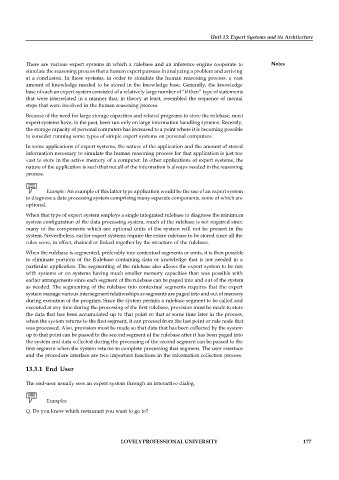Page 183 - DCAP506_ARTIFICIAL_INTELLIGENCE
P. 183
Unit 13: Expert Systems and its Architecture
There are various expert systems in which a rulebase and an inference engine cooperate to Notes
simulate the reasoning process that a human expert pursues in analyzing a problem and arriving
at a conclusion. In these systems, in order to simulate the human reasoning process, a vast
amount of knowledge needed to be stored in the knowledge base. Generally, the knowledge
base of such an expert system consisted of a relatively large number of “if then” type of statements
that were interrelated in a manner that, in theory at least, resembled the sequence of mental
steps that were involved in the human reasoning process.
Because of the need for large storage capacities and related programs to store the rulebase, most
expert systems have, in the past, been run only on large information handling systems. Recently,
the storage capacity of personal computers has increased to a point where it is becoming possible
to consider running some types of simple expert systems on personal computers.
In some applications of expert systems, the nature of the application and the amount of stored
information necessary to simulate the human reasoning process for that application is just too
vast to store in the active memory of a computer. In other applications of expert systems, the
nature of the application is such that not all of the information is always needed in the reasoning
process.
Example: An example of this latter type application would be the use of an expert system
to diagnose a data processing system comprising many separate components, some of which are
optional.
When that type of expert system employs a single integrated rulebase to diagnose the minimum
system configuration of the data processing system, much of the rulebase is not required since
many of the components which are optional units of the system will not be present in the
system. Nevertheless, earlier expert systems require the entire rulebase to be stored since all the
rules were, in effect, chained or linked together by the structure of the rulebase.
When the rulebase is segmented, preferably into contextual segments or units, it is then possible
to eliminate portions of the Rulebase containing data or knowledge that is not needed in a
particular application. The segmenting of the rulebase also allows the expert system to be run
with systems or on systems having much smaller memory capacities than was possible with
earlier arrangements since each segment of the rulebase can be paged into and out of the system
as needed. The segmenting of the rulebase into contextual segments requires that the expert
system manage various intersegment relationships as segments are paged into and out of memory
during execution of the program. Since the system permits a rulebase segment to be called and
executed at any time during the processing of the first rulebase, provision must be made to store
the data that has been accumulated up to that point so that at some time later in the process,
when the system returns to the first segment, it can proceed from the last point or rule node that
was processed. Also, provision must be made so that data that has been collected by the system
up to that point can be passed to the second segment of the rulebase after it has been paged into
the system and data collected during the processing of the second segment can be passed to the
first segment when the system returns to complete processing that segment. The user interface
and the procedure interface are two important functions in the information collection process.
13.3.1 End User
The end-user usually sees an expert system through an interactive dialog,
Examples:
Q. Do you know which restaurant you want to go to?
LOVELY PROFESSIONAL UNIVERSITY 177

